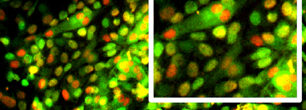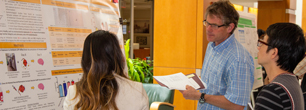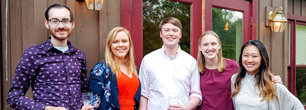Welcome to the Department of Environmental Medicine
 A message from the Chair, B. Paige Lawrence, Ph.D.
A message from the Chair, B. Paige Lawrence, Ph.D.
The Department of Environmental Medicine consists of a dedicated team of faculty, fellows, students, and staff. We are committed to reducing disease and improving health through multidisciplinary studies of environmental factors that are known or suspected to contribute to a range of diseases and disorders. We lead, support, and promote a range of activities that includes translational biomedical research, education and training, and occupational health.
Understanding how the environment that we live in influences health and disease is the key to having a healthy future for everyone. Discoveries and pioneering ideas from our department regularly drive new thinking and have had a positive impact by reducing environmentally-related diseases, uncovering new preventative and therapeutic approaches, and informing local and national policies.
The Department of Environmental Medicine serves as the administrative hub for several interdisciplinary programs, including the Environmental Health Sciences Center , Institute for Human Health and the Environment, Toxicology PhD Program, Lake Ontario Microplastics Center, Center for Inhalation and Flavoring Toxicology Research, Life Sciences Learning Center, as well as clinical programs in the Finger Lakes Occupational Health Services clinic.
The department promotes a rich and supportive learning environment for students and fellows. Our state-of-the-art research and educational programs provide broad-based training to prepare tomorrow’s leaders in toxicology and environmental health, and to develop professionals and citizens instilled with technical acumen, critical thinking skills, and dedication to service. Our core values align with principles of ICARE – Inclusion, Integrity, Compassion, Accountability, Respect, and Excellence that have been adopted across the UR Medical Center.

Research
Our diverse faculty's cutting edge research spans several areas of environmental medicine.

Education
Our multiple programs prepare individuals for a career specifically focused on research and education in environmental medicine.

People
The Department of Environmental Medicine fosters collaborative research between laboratories and investigators.
Department of Environmental Medicine - Dedicated in 1992
Department of Environmental Medicine - Dedicated in 1992
Upcoming Events
EnLight Seminar Series: "Using omics biomarkers to unravel the role of prenatal metals exposures in child development"
Allison Kupsco, PhD
Assistant Professor of Environmental Health Sciences, Columbia University
Thu, Jan 22 @ 11:00 AM
SMD | EHSC Conference Room (4.8820)For Zoom link contact Anisah Mercado
Latest News
October 1, 2025
Toxicology trainees recognized at the 2025 GEPA Awards Ceremony, October 1
September 18, 2025
Irfan Rahman quoted in "Nicotine-free’ vapes and pouches promise a buzz without the downsides. Health concerns remain"
August 6, 2025
Irfan Rahman is honored as a ScholarGPS Highly Ranked Scholar














